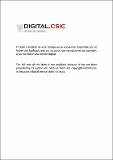Por favor, use este identificador para citar o enlazar a este item:
http://hdl.handle.net/10261/306933COMPARTIR / EXPORTAR:
 SHARE SHARE
 CORE
BASE CORE
BASE
|
|
| Visualizar otros formatos: MARC | Dublin Core | RDF | ORE | MODS | METS | DIDL | DATACITE | |

| Título: | Neoadjuvant chemotherapy in high-risk soft tissue sarcomas: A Sarculator-based risk stratification analysis of the ISG-STS 1001 randomized trial |
Autor: | Pasquali, Sandro; Palmerini, Emanuela; Quagliuolo, Vittorio; Martín-Broto, Javier CSIC ORCID; López-Pousa, Antonio; Grignani, Giovanni; Brunello, Antonella; Blay, Jean-Yves; Tendero, Oscar; Díaz-Beveridge, Robert; Ferraresi, Virginia; Lugowska, Iwona; Infante, Gabriele; Braglia, Luca; Merlo, Domenico Franco; Fontana, Valeria; Marchesi, Emanuela; Donati, Davide María; Palassini, Elena; Bianchi, Giuseppe; Marrari, Andrea; Morosi, Carlo; Stacchiotti, Silvia; Bagué, Silvia; Coindre, Jean Michel; Dei Tos, Angelo Paolo; Picci, Piero; Bruzzi, Paolo; Miceli, Rosalba; Casali, Paolo Giovanni; Gronchi, Alessandro | Palabras clave: | Chemotherapy Clinical trials Neoadjuvant Nomogram Sarcoma |
Fecha de publicación: | 1-ene-2022 | Editor: | John Wiley & Sons | Citación: | Cancer 128(1): 85-93 (2022) | Resumen: | [Background] The value of neoadjuvant chemotherapy in soft tissue sarcoma (STS) is not completely understood. This study investigated the benefit of neoadjuvant chemotherapy according to prognostic stratification based on the Sarculator nomogram for STS. [Methods] This study analyzed data from ISG-STS 1001, a randomized study that tested 3 cycles of neoadjuvant anthracycline plus ifosfamide (AI) or histology-tailored (HT) chemotherapy in adult patients with STS. The 10-year predicted overall survival (pr-OS) was estimated with the Sarculator and was stratified into higher (10-year pr-OS < 60%) and lower risk subgroups (10-year pr-OS ≥ 60%). [Results] The median pr-OS was 0.63 (interquartile range [IQR], 0.51-0.72) for the entire study population, 0.62 (IQR, 0.51-0.70) for the AI arm, and 0.64 (IQR, 0.51-0.73) for the HT arm. Three- and 5-year overall survival (OS) were 0.86 (95% confidence interval [CI], 0.82-0.93) and 0.81 (95% CI, 0.71-0.86) in lower risk patients and 0.69 (95% CI, 0.70-0.85) and 0.59 (95% CI, 0.51-0.72) in the higher risk patients (log-rank test, P = .004). In higher risk patients, the 3- and 5-year Sarculator-predicted and study-observed OS rates were 0.68 and 0.58, respectively, and 0.85 and 0.66, respectively, in the AI arm (P = .04); the corresponding figures in the HT arm were 0.69 and 0.60, respectively, and 0.69 and 0.55, respectively (P > .99). In lower risk patients, the 3- and 5-year Sarculator-predicted and study-observed OS rates were 0.85 and 0.80, respectively, and 0.89 and 0.82, respectively, in the AI arm (P = .507); the corresponding figures in the HT arm were 0.87 and 0.81, respectively, and 0.86 and 0.74, respectively (P = .105). [Conclusions] High-risk patients treated with AI performed better than predicted, and this adds to the evidence for the efficacy of neoadjuvant AI in STS. |
Versión del editor: | https://doi.org/10.1002/cncr.33895 | URI: | http://hdl.handle.net/10261/306933 | DOI: | 10.1002/cncr.33895 | ISSN: | 0008-543X | E-ISSN: | 1097-0142 |
| Aparece en las colecciones: | (IBIS) Artículos |
Ficheros en este ítem:
| Fichero | Descripción | Tamaño | Formato | |
|---|---|---|---|---|
| Acceso_restringido.pdf | 108,79 kB | Adobe PDF |  Visualizar/Abrir |
CORE Recommender
PubMed Central
Citations
12
checked on 01-may-2024
SCOPUSTM
Citations
43
checked on 29-abr-2024
WEB OF SCIENCETM
Citations
32
checked on 24-feb-2024
Page view(s)
38
checked on 30-abr-2024
Download(s)
30
checked on 30-abr-2024
Google ScholarTM
Check
Altmetric
Altmetric
Artículos relacionados:
NOTA: Los ítems de Digital.CSIC están protegidos por copyright, con todos los derechos reservados, a menos que se indique lo contrario.
